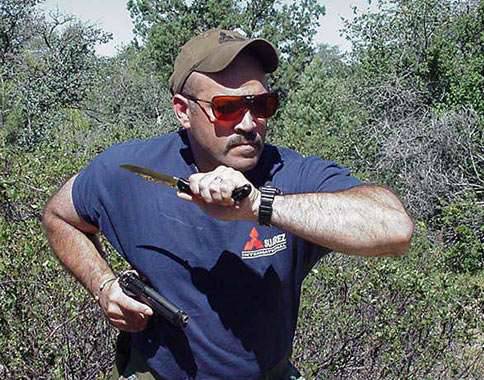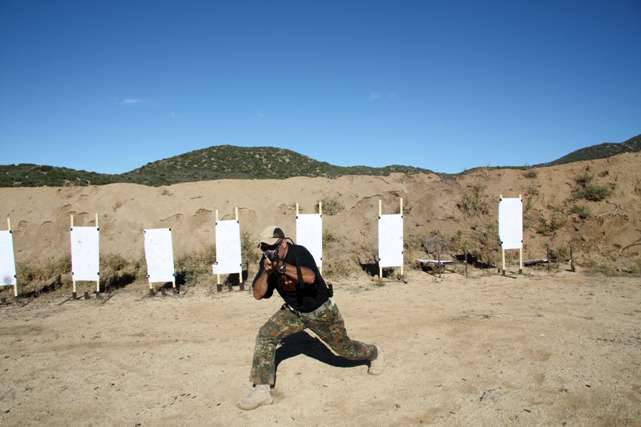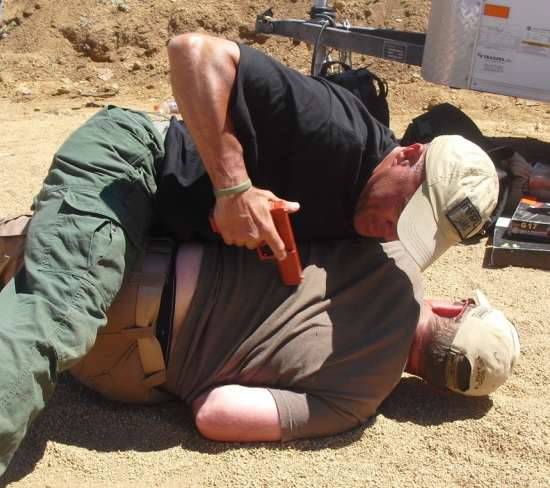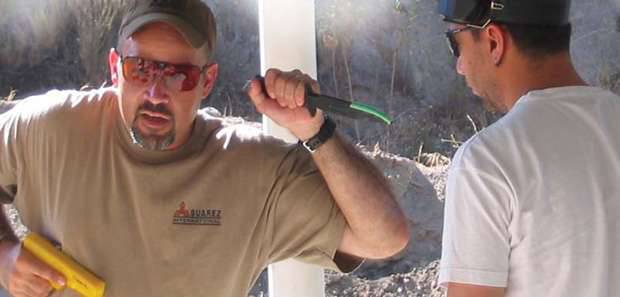Gabriel Suarez: "No one has died from excess of physical strength"

You are among the top three instructors in the United States and your students are recruited without further questioning, knowing only that they have been trained by you.
Tell us how you managed to achieve this status? Let's follow your history.
Well, thanks for the kind words. We will have to redouble our efforts to leave behind the other two instructors. I think that I came to my current position because I started teaching very early. I started teaching karate as early as 13 years, so since then I have had a lot of practice. I also have an analytical mind that helps explain pupils in a very simple way. What we do is very simple, but many instructors want everything to seem more complicated than it actually is.
How did you start your journey, what BI?
Karate Kyokushin. I reached the level of sandan (third dan). Oyama was in the USA then. We did not have a lot of money, so in the dojo, which was located in the local branch of the Christian Young People’s Association (YMCA), I rode a bicycle. Gradually, I began teaching there as a chief instructor, at the age of 16.
Has this topic always been interesting to you?
Is always. I was never interested in "physical education". Only combat themes and lifting weights.
What did you do in life? From the BI.
At a certain point, a lot of politics began to appear in Kyokushin, and I never had a penchant for it, so I left and began to study different things. At one time, I studied jiu-jitsu, western boxing, Xi Pal Ki (a variant of Korean kung fu), taekwondo, Hapkido, Philippine NB, western NB, and fencing (sword).
What kind of touched and influenced you?
Hard to say. I would say that Kyokushin had the greatest influence - my basic martial art. This is a tough and brutal system, not bullshit.
What is your engine? Where did you get it from?
I think that I rather opened it, and did not study it. In our group Kyokushin was a great emphasis on mobility and leg work (maneuvering). Then the Philippine systems, which also had a strong emphasis on footwork. You learn all these things and assimilate them. In the sense that they become part of your thinking. When I was in a shootout with three armed robbers, I did not plan on how to move. It so happened that I was moving ... about the same way I had worked out in training. This did not allow them to get into me, which I think is very good.
What methods of escape from the line of attack do you recommend?
Practice explosive and dynamic movements. Forward to the enemy, at an angle. In the Philippine systems this is often done, as well as in your System. (Ryabko - approx. M. Didenko)judging by what i saw. Some athleticism is needed here, but you have to pay for everything. Sadly, too many shooting instructors in the West do not have self-discipline in terms of nutrition, and they lose their athleticism. Perhaps this is the reason that very few teach dynamic movements.

How to turn them in?
There are a lot of our videos on the web showing how to do it. That's the beauty of modern technology. Let's say the opponent is on the 12 watch. You will move with the 10 or 11 clock on one side, or 1 or 2 on the other. Do it very dynamically. As soon as you get used to moving like this, start pulling out a gun and aiming while moving.
How did you come to the study of medieval treatises on fencing?
There is an interesting story. My son fences very well with swords, and in general he participated in the Junior Olympic Games here in the USA. But he has a great interest in old methods. We also do archery together. He shoots an English longbow, and I use Mongolian. It turns east against the west. But we began to figure out how this weapon was used in reality, and this led to the study of many ancient books.
What place does fencing take in your approach? How do you use fencing techniques for modern situations?
Yes, modern fencing is a sport, and the ability to beat with swords. Funny sport. Western traditional sword - is another matter. At close range, a pistol shot is like a shot with a sword. We developed the technique shown in the video, when working with air marshals, in order to leave the firing line at close range, in a confined space (such as an airplane). This is an old duel technique: when a lunge comes in, the fencer parries and leaves the line of attack, while at the same time sticking his sword at the enemy.
What do you think about historical European martial arts? Are they better or worse than the east?
I traveled around the world. I hope one day I can visit your country too. I found that everywhere, all people want the same thing. Including in battle. Every culture has a sword, spear, bow and arrows. They could develop independently or not. So, if you give a European a sharp stick, and the same sharp stick to a Chinese monk, and leave them for twenty years, you will find very similar solutions to the question of how to use it as a weapon.
What is better for Asian systems is the cataloging of methods and their public relations. Asians are also much more traditional. We could have a full discussion, but Europeans are generally less tied to outdated systems. In any museum in Europe, progress can be traced from swords and spears to firearms.
What are your favorite martial arts books?
Bruce Lee's “Leading Fist Path” is a great book, and a little more difficult, but no less excellent, is Burton’s “Sword Spirit”.
Once you said that you are comparing business with war. Please comment.
It is an illusion that in the business all are friends and all on the same side. This is not true. This is the same as saying that all UN countries love each other, and everyone is there for the common good. Nonsense. Everyone is there for their own good and to beat all others. Similarly, in business ... as in the UN.
Do you agree that the techniques of unarmed combat originate from weapons combat techniques?
Yes, I think so.
Tell us about the use of a knife, a pistol in the fight - including in the stalls.
Fighting in the stalls is not among my favorites. I trained her, but I do not like to fight on the ground. In my opinion, if it happens on the street, you should immediately put your weapon into the game. There are methods to do this, which again include movement to the enemy from the side, so that you can reach your weapon without hindrance. The greater the angle, the harder it is to react.
How to fight with the group?
It often happens and therefore I do not like to fight on the ground. In this case, your best friend is mobility, and try not to be surrounded. On earth, you are "bound" even by one adversary, and you cannot be mobile. If I am so "bound" and the "bad guy" attacks from behind, I am "hit."

What did you take as a basis for percussion technology?
This is all Kyokushin. We beat the bags and makivare, and then broke items. And even when it is more reasonable to strike with a palm, my nature dictates a punch.
What place in your method take Fairburn's work?
I think everyone uses them, even if they don’t realize it. This is the basis from which everyone grows. Fairburn has deeply researched many different martial arts. He brought them into a very simple system for those who had neither time nor motivation. But many of his followers do not see that this ... introductory course. You can not take a fighter trained in the classical system of Belarus Fairborn and put him against the modern military melee, because a wider education makes the modern fighter stronger.
How do you feel about the stress method?
She takes her place. But should not be used immediately. You can not take a novice and on the very first day of slapping him in the face. But the training will not be complete if the student does not feel comfortable in battle. So it is necessary, but only at the appropriate stage of development.
Why not all instructors consider the effect of stress on a person in an extreme situation?
I remember that I broke my nose during Kyokushin training in the first six months ... and I was only ten years old. I think they are afraid of losing students and nothing else. The same with any hard workout. Most students do not want to train so hard.
Why is situational training an integral part of training?
This app. But training without this application is not complete. Think of a karate player who doesn't spar at all.
Do you think jogging is important for training?
What exercises a la crossfit use (if you use at all)?
I will answer both questions at once. Technique and combat skills are important, but their strength and physical form are superior. Oyama placed great emphasis on force. In fact it (Kyokushin - approx. M. Didenko) called "the strongest karate." I do weight lifting and aerobic exercises every week. In 56 for years, I lift in a deadweight over 400 pounds (approximately 181 kg) and wring out on uneven bars with a weight equal to mine - that is, with 180 pounds (approximately 81 kg). I know that I can hit a man so much that he does not want to continue the fight. Or I can, if necessary, drop it from the balcony. Nobody died from the excess of physical strength.
What can you say about working with a knife with a reverse grip?
I think my opinion about the knife is a little different from the majority opinion. Although, I learned from many instructors in NB, I think that the knife today is a weapon of attack against the most extreme case. Knife-knife situations are rare nowadays, but a knife against a healthier and stronger opponent, like a knife against several attackers, works. I also recommend using the knife as a weapon for women who do not want to carry a firearm, or for children who cannot wear it. After all, our world is dangerous. My way of learning a knife is not to show it. Then, if necessary, quickly pull out, and quickly stick in the neck, face, abdomen or groin without stopping. Think of how criminals use a knife in prisons, and you will understand the idea. In fact, it is not "art". Sometimes the knife is taken by reverse grip, sometimes direct, but the concept is the same.
Your method is interesting, when in one hand a knife, in another a pistol - what is it for?
This is the transition from one weapon - usually a knife - to a pistol. In some cases, only one weapon is available, or it is immediately at hand, but the person wants to aggravate the conflict. This method allows you to use a gun without throwing the knife.

What can you say about the Ryabko system, which was mentioned in its materials? Have you taken anything from it for yourself?
I have never trained with Ryabko. I learned a little about Sistema from a former special forces member in the United States and I liked her. I see many similar properties and characteristics with other well-developed martial arts.
Do you agree that the systems in which the firearms are not studied are outdated?
Need to understand the goal. It could be health, exercise, or something like that. It may even be the preservation of tradition. Recently I saw a demonstration of Yabusame. This is a Japanese horse archery. This is a martial art, but I do not see its use in modern conditions. Someone may still admire this skill and devotion, but will its study give the possibility of practical application in the modern world? Probably not. If the goal is to be a strong modern warrior, ignoring the existence of firearms is stupid.
How do you see the future of self defense / martial arts systems?
Oh, I think that modern technology will help us overcome the oceans and distances, and even overcome the boundaries and policies, and share with each other. We have people committed to preserving tradition, and I applaud their efforts, as they remind us where we come from, but in the end there will be only one martial art. We are already seeing the beginning of this process in UFC / MMA. As self-defense goes beyond hand-to-hand combat, much will depend on what is available to people. I am told that the United States is known for "arrows." That is why we have such an opportunity in this country. And in Canada, perhaps this is no longer the case.
How is your training?
I like to teach as a professor at the university. I do not yell, and do not scream, and not annoyed. I think they are recruited in military training, where this is often the case. But special units, as well as civilian ones, who take individual lessons, pay for the training, and want to learn, and not just listen to the sergeant instructor's drill on the drill. Some American instructors have such a reputation, and I think they cover up this lack of knowledge. Most of the great teachers I saw speak politely and are "warrior gentlemen" (as I call it).
Single training, then - in a group?
Well, it depends on the situation. I do some individual training, but it’s easier and harder in a group. Easier, because the energy in the group sessions is stronger. But the time for each shooter / soldier turns out less. From a financial point of view, group lessons are more reasonable.
Learning objectives?
We define goals for each group and try to ensure that everyone achieves at least these specific goals. Someone, of course, exceeds expectations, someone is not so good. The goal of each day is to make them all better at studying.
What skills does your course graduate get?
I think the best skill is that they do not live in fear. So many people are motivated by fear motivation in their lives. They seem to be afraid of everything. Don't live like that. A properly trained person will not look for trouble (if it is not his job), but when trouble comes, he will not cry or piss in his pants. He will think: "So, I was hoping to avoid it, but it came, and I will enjoy every second." At this point, I disagree with many coaches in the United States who successfully do business on the philosophy of fear. But so you do not win. Roosevelt once said: "Every person who knows the power of pleasure in a battle knows what it is when a wolf wakes up in his heart." We learn to feed this wolf.
What courses are most popular now?
Of course, the most popular courses are guns. Everyone in the US has a handgun, and many people carry it every day. I think that if a Republican appears in power, then among other things the number of armed citizens will increase, since the laws on weapons will not be so strict.
Tell a story when your student was able to protect themselves and / or their loved ones (or completed a task).
There were a lot of them, but I respect the right to personal information when necessary. The last I received from the soldier who fought with our common enemy. His automatic rifle was damaged and stopped working, and the "bad guy" was approaching from a distance of 75 meters. The soldier pulled out a pistol (on which we put a collimator laser sight, and also drove him and his comrades through the course of work with the pistol), and fired at the "bad guy" - killing him - from a distance of 75 meters. Yesterday he sent a short message about it. Someone will say that such a shot is impossible to do - but not for everyone.
Information